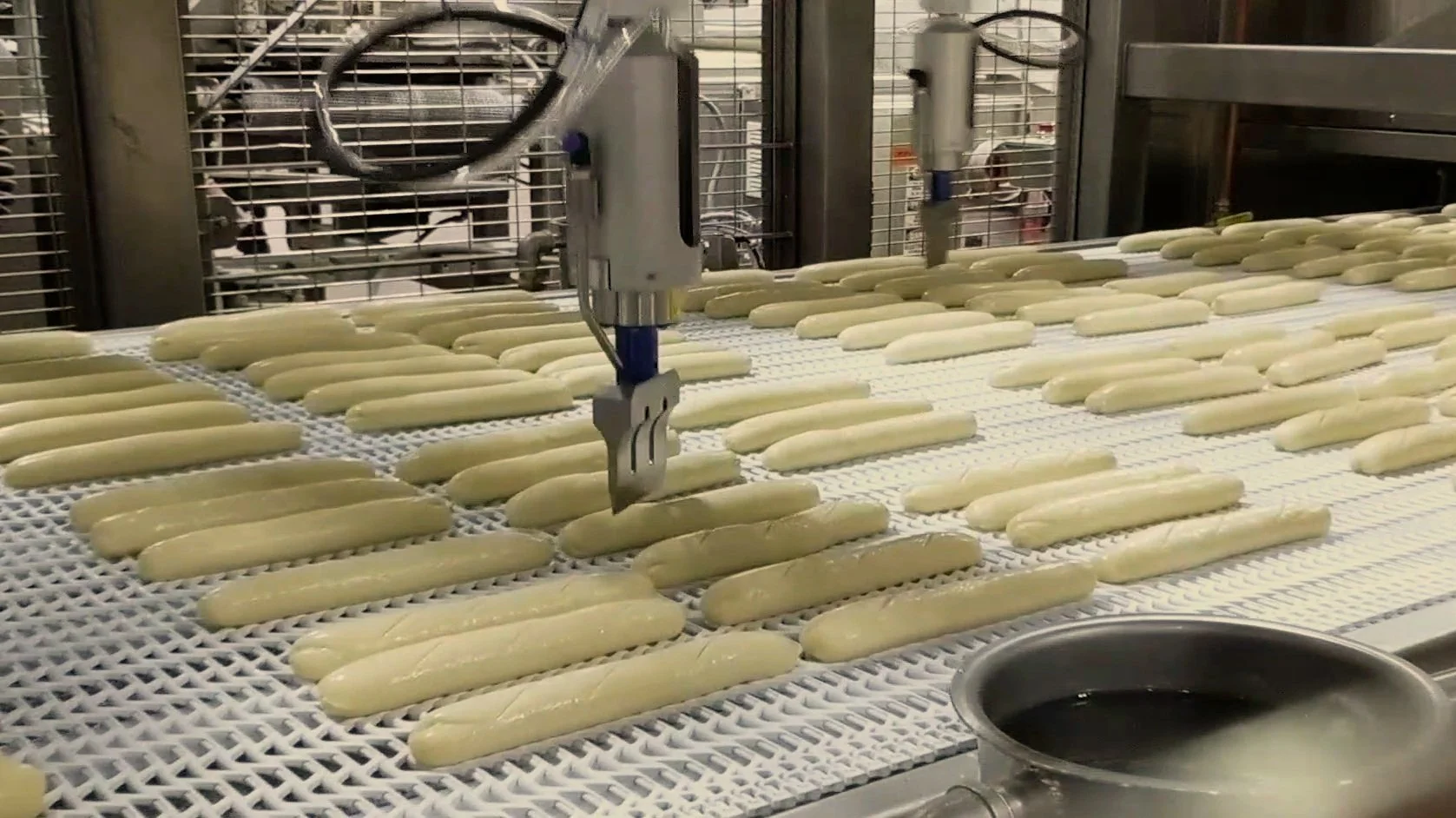Industrial bakeries are quickly adapting robotic technology to maximize their efficiency and meet their customers’ demands. You likely have considered a robotic solution if you haven’t already integrated one into your production. While robots can be a complex topic to learn, that should not stop you from understanding the technology you rely on daily.
ABI has worked with commercial and industrial bakeries to install a range of robotic solutions for their production lines. With our experience, we put together the must-know information on what gives robots their functionality. Our guide focuses on End of Arm Tooling (EOAT), which is the device that allows a robot to perform a task. You will learn about the tools used in bakery production and understand which ones are best for your bakery processes.
End of arm tooling is a piece of equipment that attaches to the end of a robotic arm. There are a variety of attachments and each one provides a robot with specific functionality. Tools are often interchangeable and are also known as end effectors.
Here are five EOATs that you will find in industrial bakeries and are part of ABI’s robotic solutions.
Drag blade
The drag blade mimics a lame slashing tool that bakers use to cut the surface of yeasted dough by hand. It looks like a pointed blade with cutting edges on both sides. Although its core application is scoring, it still provides industrial bakeries flexibility when combined with the power of robotics.
Programming gives bakeries the ability to customize how each score is made. Dimensions, such as length, depth, and angle, can be tailored to the bread in production and saved in a catalogue of styles. The flexibility the drag tool offers is unmatched.
Speed is an important factor in bakery production and the drag tool does have some limitations. In comparison to other EOATs, it does not process the product as quickly. Especially for more intricate scoring, the time to process one piece of dough will be above average. The difference is a matter of seconds, and our engineers calibrate the robotic arm to maximize its efficiency.
Ideal for scoring artisan breads, rolls, buns, and baguettes
Type of robot required: 6-axis robot
Plunge blade
The plunge blade is another cutting tool and, as the name suggests, moves in an vertical motion. Unlike the drag tool, this blade has one cutting edge with a fixed length. In addition to scoring, it is often used to portion product for consumption. Regardless of the product, this tool makes only one style of cut.
The simplicity of the plunge tool is both its advantage and shortcoming. Since the blade’s movement is simple, the action can be repeated quickly, which makes the faster choice for scoring or cutting faster. The downside is the tool does not offer any variety in cut length, which means the number of processes it can support is limited.
Ideal for scoring certain types of buns, breadsticks, rolls, or for cutting slab cakes, brownies
Type of robot required: 6-axis robot or 4-axis delta robot
Soft grippers
Soft grippers have three to five silicone “fingers” that work together to pick up product gently. The fingers are flexible and can conform to almost any shape. It is best for handling delicate products or ones with curved or uneven surfaces.
Since it mimics the functionality of human hands, there are many applications for this type of EOAT. Board loading/unloading, inspection, and packaging are common uses, however soft grippers are an ideal choice for most product handling (pick and place) applications.
While silicone allows the soft grippers to be flexible, the downside is the material is not metal detectable. In industrial bakeries, metal detectors are used for quality control. In this situation, we recommend choosing grippers that are made with a polymer that can be found by these detection systems.
Ideal for handling doughs, buns, rolls, boules, pretzels
Type of robot required: 6-axis robot or 4-axis delta robot
Vacuum grippers
Vacuum grippers use the power of suction to handle materials. The cups form a seal on surfaces to pick up product or boards and trays. These grippers work best on surfaces that are flat, or mostly flat. This makes them an ideal choice for board handling, plus board loading/unloading, depanning, inspection, product assembly.
In addition to having many applications, vacuum grippers are an established robotic technology which means service and maintenance are easier than recently developed EOATs. They are also capable of handling heavier loads than other pick and place type tools.
The functionality of vacuum grippers relies on flat surfaces and the cleanliness of the airflow channel to form a proper suction. Dust and fine particles can get pulled in and block airflow. This reduces the vacuum strength and can compromise its effectiveness. However, good airflow is easy to maintain with the use of compressed air dusters.
Ideal for handling boards, trays, pans, frozen products, loaves, boules
Type of robot required: 6-axis robot or 4-axis delta robot
Needle grippers
Needles grippers are another type of EOAT that perform the pick and place function. Thin needles are inserted at an angle, forming an ‘X’ inside the product. This formation allows the grippers to have a firmer handle on the product.
Where soft grippers and vacuum grippers fail, needle grippers are the solution. This is often the best choice for a unique set of products; however, the uses are the same as vacuum grippers. For example, cinnamon buns or frosted brownies have surfaces that cannot be disturbed, so needle grippers make minimal contact while handling them.
At the same time, needles puncture the product, which may be acceptable for some but not others. Bakeries must determine if small holes will compromise the final product’s quality. In the production environment, needle grippers also process product slower than other tools. This is especially true if the product’s density is higher.
Ideal for handling loaves, buns, cakes, cinnamon buns
Type of robot required: 6-axis robot or 4-axis delta robot
EOATs are a central component of ABI’s robotic solutions. With each tool, you can transform the processes that make up their production line. Understanding the capabilities of each EOAT helps you strategically optimize and grow your bakery with the support of advanced technology and our expert team at ABI.
Is your bakery ready for robotics? Get in touch with our team!






